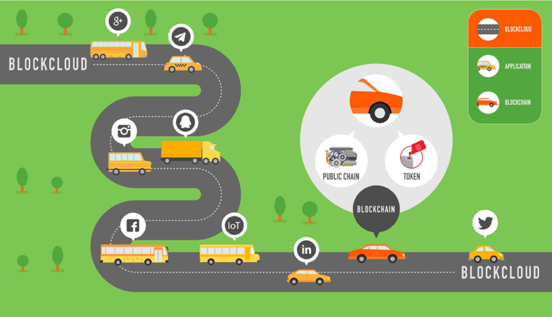(This is the AMA, re-organized from the ICOgens.com video with Dr. Ming on August 8.)
Today we have the pleasure to talk with Dr. Zhong Xingming, the CEO of Blockcloud which is a novel project that is attracting tremendous interest from the community.
Lam: Hi Dr. Ming! I believe most of us know about you. However, many of us are wondering why you’ve chosen Blockcloud as the name of project? Does it have any meaning or just a random name?
Dr. Ming: Thanks Lam. That’s a great question. Blockcloud implies the combination of many blocks and clouds. “Block” relates to the Blockchain world and implies a form of building block for the Internet itself. The Internet consists of several layers and each layer can be thought as a block. The word “cloud” expresses the idea that the Internet involves end-to-end communication over a cloud-based communications model. That is why everything is in a cloud-based network. That’s why we use the word “cloud”. It is to represent our idea of the Internet. The combination of the words Block and cloud allows us to represent our core belief and idea.

Lam: Thank you. What problem would be solved by Blockcloud?
Dr. Ming: Blockcloud aims to reinvent the roads with modern applications to drive on. It’s Blockchain-based advanced TCP/IP that improves and upgrades the existing Internet. By combining the advantages of Blockchain and future internet technology, it re-constructs the technology layers below our current Blockchain networks and internet applications. So Blockcloud serves as the core building block to provide constant connectivity for dynamic networks. It provides better stability, scalability, incentive, security and fairness to upper layer applications.

Lam: I want to know more about applications of Blockcloud in the IoT field. As we can see, in the crypto world, Blockcloud faces a lot of competitors, like IOTA, IoT chain or IoT block, so what are the competitive advantages that can allow Blockcloud to achieve success in this field?
Dr. Ming: Appreciate the question. We are not really competitors but can actually collaborate because we are on the different layers of the internet. For most IoT Blockchain solutions, they are on the application layer of the internet stack but Blockcloud is on the TCP/IP-layer which acts as the underlying infrastructure and is for TCP/IP-layer Blockchain solutions. We have not seen any other chain that is currently working on this. Most chains are on the application layer of the internet stack. For example, if you think about the transportation system, Blockcloud is like the road and other Blockchain technologies are something like the cars, so we are not the competitors, but we can collaborate to make the world and internet better. We have been collaborating with many IoT public chains, on a private level and will release this information in due time. One of these companies is WTC and have built a very strong strategic collaboration with them. If we were truly competing, we would not be able to collaborate on such a level.
Lam: Impressive! You mentioned a lot about the TCP/IP and provided a few great examples. Unfortunately, many people may not be familiar with the concept. Could you explain what TCP/IP is and why it is needed to integrate the so-called CoDAG?
Dr. Ming: TCP/IP is the fundamental protocol of internet. TCP contributes 90% of internet traffic and IP is the dominant protocol of the network layer. Everything currently in the internet is running over the IP. The reason why we integrate TCP/IP with Blockchain is to make the internet secure, trustful, and to have the internet motivate the upper layer service distributors. TCP/IP was designed 50 years ago. The requirement of Internet has evolved, so we do need to evolve TCP/IP to provide better support for the internet and upper layer applications. Blockchain technology is a very strong and powerful weapon to solve the issues associated with TCP/IP and we are combining the advantages of Blockchain to make TCP/IP better.

Lam: Thanks for your answer. In your whitepaper, we have also noticed another concept called Service Centric Network. How does it work? Could you be more specific about this network architecture?
Dr. Ming: Service-Centric-Network (SCN) is a new network architecture that aims to support efficient provisioning, discovery and execution of service components distributed over the network. The current internet architecture is centralized and agnostic of wide-area network performance outside of the data center, and as a result this is unfit for geographically distributed services with tight QoS constraints and high bandwidth built with computation demands. SCN implies services and network routing at a granular level. The SCN also makes it so that the service remains close to the consumers depending on demand and the import dimension is light-weight in direction between layers for service basement and in that network instant selection result over-burdened lighter layer with service specific logic. Put simply, if you use YouTube to watch a movie such as Harry Potter, traditionally, you need to understand clearly about who provides the movie and where the movie is otherwise you cannot access the movie. However the truth is that you only care about whether you like the movie and whether it’s clear and smooth. SCN allows you to directly access the movie, rather than having trouble in finding who provides it or where it is. That makes the service much more convenient and easy to use.

Lam: Thank you. This is definitely very interesting technology being created by Blockcloud. Let’s move on to the next topic. What have been Blockcloud’s primary accomplishment so far?
Dr. Ming: Yes, Blockcloud started at the end of last year, but we are not starting from nothing. We’ve been studying SCN for about 10 years and made a lot of publications in top academic journals related to internet research and we also have an MVP for SCN. Although it’s not open source yet, it eventually will be. Currently it is under review by authoritative reviewers of great rating companies of the world. We expect to see their review articles in the near future. We have finished the design work of the Blockcloud architecture and currently the development team is implementing the CoDAG layer to record the transactions. As for the fundraising, we have finished the private sale, having attracted 100+ investors from 18 countries and regions around the world. The Whitelist for crowdsale investors will be announced soon. For now, we are aggressively talking to exchanges, and we hope to see you on an exchange in the near future.
Lam: Thank you very much. I see some members of the team are from the Shenzhen Oudmon Technology Company, so does this company have any relation with Blockcloud?
Dr. Ming: Thanks for your good question. The core members of Blockcloud came from Oudmon. We operated Oudmon before and it started 6 years ago. However Oudmon and Blockcloud are completely separated from one another. Oudmon is a company producing IoT devices, like wearable devices. Now it’s certainly a mature and profitable company, with around 100 million CNY in sales every year. The experiences of Oudmon definitely helped us understand the art of operating a company, and allowed us to learn how we can make Blockcloud successful, but since Oudmon is profitable and mature, the core team, especially the development team has been fully involved in Blockcloud and we have invited new people to manage Oudmon. The two companies are completely separate, and those who came from Oudmon are working on Blockcloud full time. However, Oudmon can be one of the strategic partners of Blockcloud after the mainnet of Blockcloud is launched. However, I want to clarify that Blockcloud is not designed for Oudmon, but for involving the internet, so the blueprint of Blockcloud is much bigger than that of Oudmon.

Lam: For now, you are working full-time on Blockcloud and we are shocked when we look through the advisory board. It’s equal to the Great Wall of China, so except financial support, is there any support from them to the Blockcloud and is there any insurance for them?
Dr. Ming: For now, Blockcloud has 100+ investors from 18 countries and regions. The manner in which we chose our investors and collaborators was very rigorous. We are not receiving investment only for money purpose, but always try our best to attract strategic partners who can help us make the project successful in the long term. Most of the investors are helping us to build a global successful project from the perspective of development, marketing, computing, investor collaboration and exchanges. We feel very lucky have such investors and partners.
Lam: Last but not least. Everyone is expecting the answer about what the price of the token will be? And what quantity will be available during the crowd sale?
Dr. Ming: 0.01 USD each, total quantity is at least 1 million US dollars in crowd sale. The details will be announced in our official channels.
Thanks for reading through the interview. We hope you learned a lot and encourage you to remain engaged with our growing community.

(Sticker from Blockcloud community)